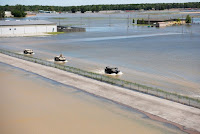Thousands of miles of levees stretch across the U.S., built to keep swollen waterways from inundating towns, farmland and critical infrastructure. But, as the residents of Pocahontas, Ark., found out this week when drenching rains caused the Black River to overtop and breach the local levee system, living behind a levee is not an absolute guarantee of protection.
The river’s waters rushed over the earthen berm, spreading out over six miles and sweeping into homes, turning roads into rivers and likely causing millions of dollars in damage.
The event is one of many in recent years that underscore the often overlooked flood threat that remains to communities even when levees are in place, experts said, particularly when the levees aren’t well maintained and communities lack the funds to fix them.
Not only that, but the extensive use of levees to control floodwaters can actually exacerbate flooding when they fail, as they did in Pocahontas. And the problem is only likely to get worse as climate change continues to cause more and heavier downpours.
As the atmosphere warms from the continued accumulation of heat-trapping greenhouse gases, it is able to hold more moisture, making heavy downpours more common. The top 1 percent of such downpours have increased by 60 to 80 percent in Arkansas since the 1950s, according to a Climate Central analysis.
Of the seven biggest flood crests along this stretch of the Black River, four have happened within the last 10 years.
Read more at The Overlooked Risk of Levees as Rainfall Rises

No comments:
Post a Comment